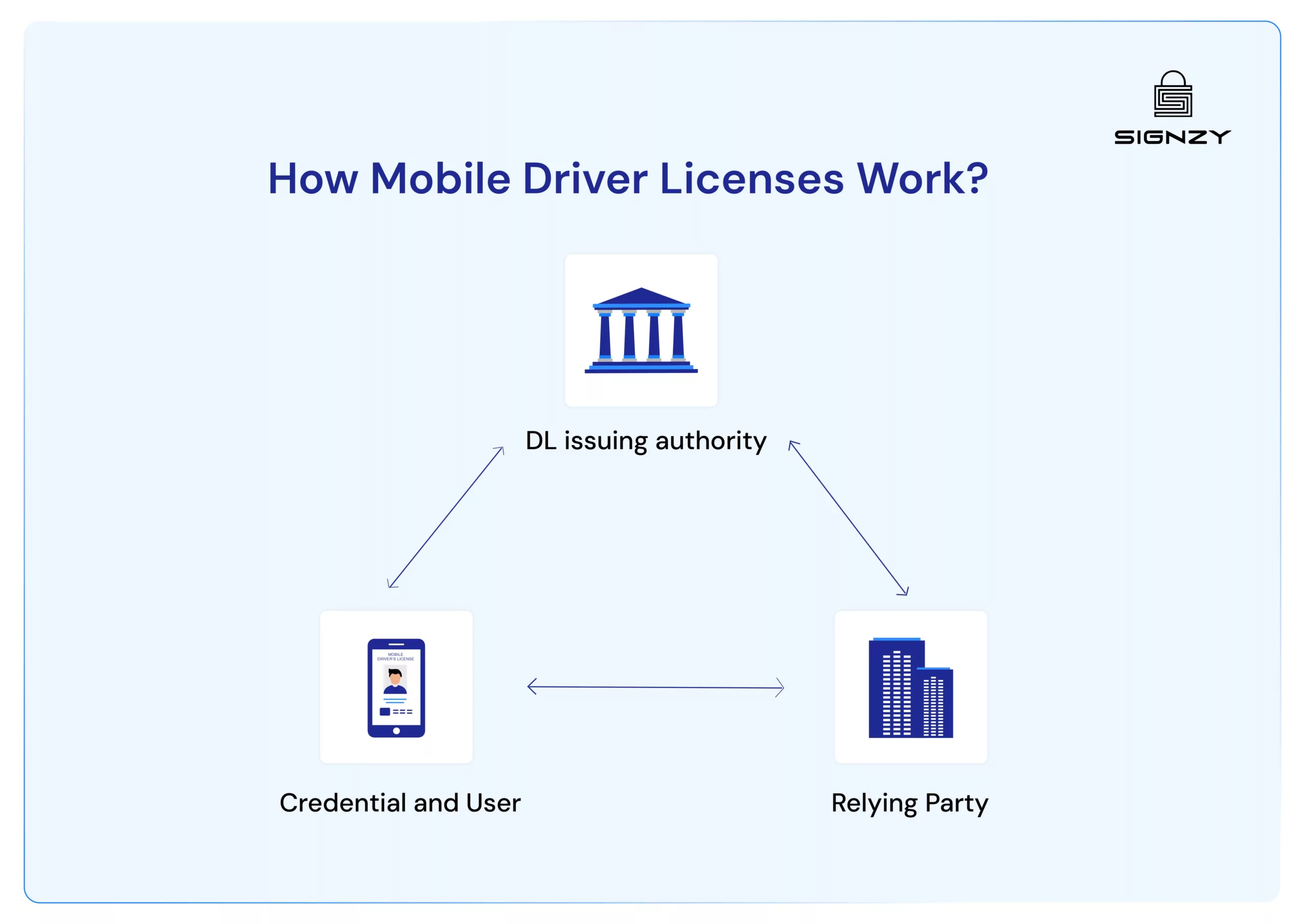Mobile Driver’s License (mDLs) – What They Are, How They Work, Use Cases and More
December 3, 2024
7 minutes read
- The mDL revolution is spreading across America, with over a dozen states either rolling out or experimenting with the technology.
- mDLs use sophisticated QR codes, NFC, and Bluetooth technology for seamless verification across different devices.
- California’s digital license pilot program alone serves 1.5 million residents through both major wallet platforms.
Remember when paying with your phone seemed like science fiction? Now we barely blink when someone taps their device at checkout.
The same revolution is happening with driver’s licenses. That plastic card in your wallet – the one that’s barely changed since the 1950s – has finally gotten its digital upgrade. Mobile Driver’s Licenses (MDLs) can turn your identity into secure digital credentials that live right on your phone.
Look around your business. Digital payments. Cloud storage. Remote work. Everything has evolved to meet modern demands.
And MDLs are the next big shift your business shouldn’t miss.
Stick with us for the next 6 minutes – we’ll break down everything you need to know about MDLs in business – what they are, how they work, how they can benefit your business and more.
What is an mDL?
A Mobile Driver’s License (mDL) is a secure digital version of a physical driver’s license that’s stored on a smartphone. Think of it as carrying your state-issued ID in your phone instead of your wallet – but with added layers of security and privacy controls. These digital IDs live securely in your phone’s digital wallet (like Apple or Google) or in state-approved applications designed specifically for mobile licenses.
Also, the “digital version” here does not mean a simple photo or PDF version of a physical driver’s license. Rather than being a simple image, mDLs pack verified data directly from state motor vehicle departments into encrypted digital packages with advanced security features.
This direct connection to official state records is particularly important for businesses like banks and financial services that need absolute certainty about customer identities.
How Are mDLs Different from Traditional DLs?
Mobile Driver’s Licenses (mDLs) represent a significant advancement in five key areas:
-
Faster Identity Verification
When someone shares their mDL, verification occurs instantly through secure digital channels – no more waiting for document reviews or manual approvals like traditional processes.
-
Government-Verified Data
Every mDL taps directly into state motor vehicle departments (DMVs – the government agencies issuing driver’s licenses). This means each piece of information comes pre-verified by official sources, eliminating worries about forged documents or outdated information.
-
Biometric Protection
Remember how smartphones started using facial recognition to unlock? mDLs take that same technology and make it essential. Before anyone can use their digital license, they need to prove it’s really them through facial recognition or fingerprint scanning.
-
Smart Privacy Features
Traditional IDs are all-or-nothing – show your license, show everything. mDLs break this mold by sharing only what’s needed. Need to prove age at a store? Share just that. Opening a new account? Share only the required details.
-
Real-time Validation
Physical cards can’t tell you if they’re still valid. mDLs can. Each verification happens in real time, instantly confirming if the license remains active. This immediate verification reveals if a license has been revoked or suspended – something impossible to determine just by looking at a physical card.
These features work together to create smoother customer experiences while providing stronger identity assurance – exactly what businesses need.
How mDLs Work?
So, firstly understand that mDLs are not going to have any new information. They will contain the same information as any physical DL:
- Name
- Date of birth
- Address
- Driving class
- License number
- Issue date
- Expiration date
- Issuing jurisdiction
- Restrictions
It works differently in terms of issuance and maintenance.
See the three stages below to understand:
Stage 1: Before an individual receives a mobile driver’s license, their identity must first be validated by the application that will house the mDL in accordance with both international standards and state requirements. This typically involves uploading both sides of their physical driver’s license or state ID for verification against official databases.
Stage 2: Most digital wallets and mDL applications then require users to complete a selfie verification process. Users must take a series of real-time selfie photos, which are compared against their ID photo. This step helps verify that a real person is requesting the mDL and prevents spoofing attempts.
Stage 3: Once issued, the mDL is encrypted and securely stored on the user’s device. To access or share their mDL, users must authenticate using biometrics (like face or fingerprint scans) or a PIN/password. When sharing information with a verifier (like a financial institution), users can review exactly what data will be shared before transmission.
On the flip side, it becomes easy for businesses to conduct KYC and AML screening.
A real win-win.
Here’s how it becomes easy for businesses.
How to Verify mDLs?
The verification process itself is touchless and electronic. When a business needs to verify its user’s identity, the mDL transmits encrypted data to the verifier’s system, which can then be verified by APIs, digital solutions, or manually by humans.
The information has already been validated by the issuing authority (typically the state DMV), which reduces verification time and improves accuracy compared to manual document checks.
There’s one more benefit for businesses – mDLs can automatically populate forms with verified data, reducing manual entry and errors.
The built-in biometric verification and encryption provide additional security layers, while selective disclosure capabilities ensure only necessary information is shared for each specific verification need.
Which States Accept Mobile Driver’s Licenses?
Mobile driver’s licenses are now active or in plans in 13 states and territories across America. These include:
- Alabama
- Arizona
- Colorado
- Connecticut
- Delaware
- Georgia
- Hawaii
- Kentucky
- Louisiana
- Mississippi
- Oklahoma
- Ohio
- Puerto Rico
The rollout story gets even more interesting at the state level.
Some states, like Arizona and Oklahoma, have taken matters into their own hands, creating dedicated apps that reflect their unique needs and preferences.
Others have decided to partner with tech giants Apple and Google, letting residents store their digital IDs right alongside their digital credit cards and boarding passes.
At the federal level, the Transportation Security Administration (TSA) stands as the first major adopter.
PreCheck travelers at select airports can already flash their digital IDs – a small but significant step toward wider acceptance.
But there’s a vital deadline on the horizon: after May 7, 2025, federal agencies will only recognize mDLs from states with special REAL ID waivers. This requirement will fundamentally shape how these licenses evolve and operate at the national level.
How Can Mobile Driver’s Licenses Help Businesses – Use Cases
mDLs particularly help organizations bound by Know Your Customer (KYC) and Anti-Money Laundering (AML) requirements as they offer a reliable digital path to meet verification mandates while reducing operational friction.
-
Remote Identity Verification
The rise in digital services has made remote identity verification essential. mDLs excel here by eliminating common pain points – no more blurry ID photos or manual data entry. Instead, verified data flows directly from the credential to the verification system, making remote onboarding smoother and more reliable.
-
Risk Reduction and Security
Built-in security features in mDLs help organizations reduce verification errors and detect fraud more effectively. The combination of biometric security, encrypted data transmission, and real-time validation creates a robust framework for secure identity verification.
When an mDL shows a match, organizations can trust that verification with higher confidence than traditional methods.
-
Operational Efficiency
Traditional identity verification often involves multiple steps, manual reviews, and back-and-forth with customers.
mDLs streamline this process through automatic form population, instant verification checks, and standardized data formats. This efficiency translates directly to faster processing times and reduced operational costs.
-
Enhanced Privacy Controls
Perhaps most importantly for modern business operations, mDLs introduce sophisticated privacy controls through selective disclosure.
Organizations can request and receive only the specific data elements needed for their verification requirements – a significant improvement over traditional IDs that show all information regardless of relevance.
Start Here
When implementing mobile driver’s license verification, organizations need reliable technical infrastructure to support the process. Solutions like Signzy’s Driver License Verification API and Face Match API work together to enable secure identity validation.
Combined with OCR capabilities and liveness checks, our tools help create a seamless verification experience while maintaining the security standards required for digital identity verification.
FAQs
Are mobile driver's licenses legally equivalent to physical licenses?
Yes. When issued by state DMVs, mobile driver’s licenses carry the same legal status as physical licenses. However, not all states or organizations currently accept them, so carrying a physical license as a backup remains recommended.
Can businesses verify mDLs without special equipment?
Currently, businesses need compatible readers or verification systems to properly validate mDLs. The specific technology depends on the state’s implementation and can include APIs, NFC readers, QR code scanners, or specialized verification apps.
What happens if someone loses their phone with an mDL?
Mobile driver’s licenses are protected by device security (like biometrics or PINs) and can be remotely deactivated if a device is lost. Users can reinstall their mDL on a new device through their state’s verification process.
Do mobile driver's licenses work across state lines?
Interstate acceptance varies. While some states recognize mDLs from other jurisdictions, there’s no universal acceptance yet. The TSA’s acceptance program at select airports represents early progress toward national recognition.














